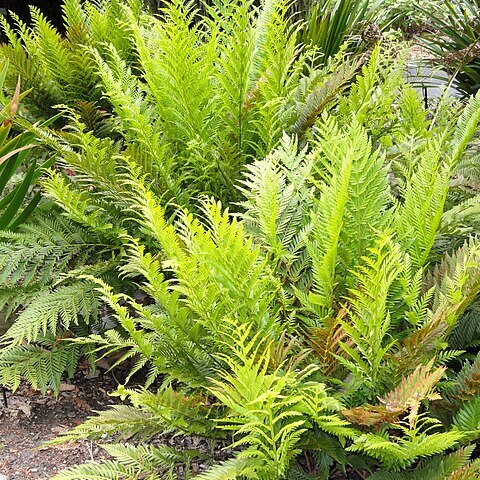Stem usually a massive unbranched, upright caudex, covered by a thick layer of persistent stipe bases and roots. Fronds caespitose, erect to arching, many, up to 1.05 m long. Stipe rigid, greenish to stramineous, terete, up to 340 mm long and 12 mm in diam., initially set with unbranched uniseriate hairs, narrow hair-like scales, and broad entire scales of which apices terminate in large, ovoid, non-glandular cells, glabrous later. Lamina 1-pinnate-pinnatifid, oblong-acute, up to 650 x 200 mm, with up to 22 petiolate pinna pairs. Rachis stramineous, terete, glabrous with age. Pinnae firmly herbaceous to subcoriaceus, opposite to alternate, proximally more widely spaced, narrowly lanceolate to oblong-acuminate, up to 230 x 43 mm, pectinately lobed; pinna rachis stramineous, narrowly winged towards apex, pronounced adaxially, glabrous; segments cultrate, up to 35 x 6 mm, set at an angle of 40°-50° to pinna rachis, serrate; venation evident, forked once, ending at margins in teeth; petioles up to 5 mm long. Sporangia massive, with a thick, short stalk, confined to the not conspicuously contracted basal pinnae and segments, on all parts of veins, appear acrostichoid at maturity; annulus a lateral band of thickened cells, poorly developed.
Rhizome short or forming a trunk to 3 m tall, with a thick brown root mantle. Stipe smooth. Fronds lanceolate, 0.5–2.5 m long, 15–60 cm wide, occasionally as small as 10 cm long, 4 cm wide, 1-pinnate-pinnatifid to 2-pinnate, glabrous or pubescent along veins, shiny, pale green; adaxial surface paler. Pinnae 10–30 cm long, 2–12 cm wide, lanceolate, more rarely ovate to oblong in reduced forms; sporogenous pinnae occasionally shorter than sterile ones. Pinnules broadly attached at base, oblong-elliptic, 1.5–8 cm long, 4–9 mm wide; margins serrate. Sporangia at first in discrete groups, then confluent, green turning reddish brown.
Rhizome up to 0.12 m in diameter, bearing tufted fronds at apex. Fronds erect, set with a loose rufous tomentum during development but glabrous at maturity; stipe pale brown, smooth, up to 15 mm in diameter near base; lamina narrowly oblong, up to 1.1 x 0.44 m; pinnae cultrate to narrowly lanceolate, usually set at an angle of 40-50o to rhachis, pinnatifid almost to costa into cultrate, minutely serrate, acute, coriaceous lobes up to 40 x 5 mm with broadened adnate bases. Sporangia usually on distal third of pinnae.
Stock stout, erect, up to 6 dm. diam. and 12 dm. tall. Stipes up to 1 cm. or more diam. and 6 dm. long, brown, grooved, smooth; rhachides and costae similar. Primary pinnae 10-20 cm. long; pinnules coriac., bluntly toothed, 1·5-5 cm. long, 2-5 mm. wide, about linear-lanceolate, uppermost confluent. Sporangia crowded on veinlets of lower pinnules, often hiding surface of pinnule.
Lamina up to 1.1 x 0.44 m., deeply 2-pinnatifid, narrowly oblong in outline; pinnae cultrate to narrowly lanceolate in outline, usually set at an angle of 40–50º to the rhachis, pinnatifid almost to the costa into cultrate minutely serrate acute coriaceous lobes up to 4 x 0.5 cm. with broadened adnate bases.
Perennial with massive rhizome. Fronds erect, stipe with loose tomentum, lamina up to 1.5 m long, but never this long in region, 2-pinnatifid, pinnules oblong with broadened adnate bases, sporangia on basal third of pinnae. Sori confluent at maturity.
Perennial with massive rhizome. Fronds erect, stipe with loose tomentum, lamina to 1 m, 2-pinnatifid, pinnules oblong with broadened adnate bases, sporangia on distal third of pinnae. Null Sori confluent at maturity.
Rhizome erect, bearing tufted fronds at apex. Fertile pinnules not differentiated from sterile pinnules. Sporangia usually on distal third of pinnae. Lamina narrowly oblong, up to 1.1 x 0.44 m.
Rhizome erect to procumbent, covered with the persistent winged bases of the stipes to form a rhizomatous mass up to 12 cm. in diam. bearing tufted fronds at the apex.
Sporangia borne on the under surface of undifierentiated pinnae usually in the lowest 1/3 of the latter.
Fronds erect, set with a loose rufous tomentum during development but glabrous at maturity.
Stipe pale-brown, up to 1.5 cm. in diam. near the base, smooth.

